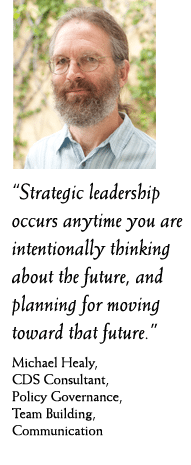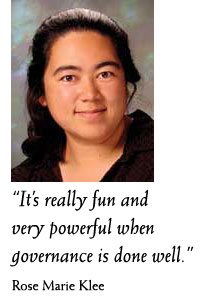What would happen if everyone in a whole community understood their role in achieving a common purpose? It’s not hard to imagine that lots of really positive things could be accomplished, some of them beyond our wildest dreams.
That’s why it is critical to the success of a cooperative that everyone has a role in determining the co-op’s future. One of the fundamental differences of cooperation is that our business strategies are focused on strengthening relationships with all our stakeholders that will result in vibrant, democratic organizations. The purpose for cooperatives in generating surplus is to have resources to enact a positive impact on our local economies, the environment, and communities, not maximize return on shareholder investment. Strategic leadership in co-ops is about building on owner needs and values to direct the co-op’s future.
 Yet our world is saturated with business books and conference speeches about strategic leadership, often focused on capital-intensive values, adding a layer of confusion about what strategic leadership is about. “Strategic” is the word du jour. The paradox is that the word often means different things to different people. Your “strategy” might be my “tactic,” for example. Michael Healy, Columinate board trainer, said that a less complicated approach may be to think about strategy as anything that relates to future plans. “Strategic leadership occurs anytime you are intentionally thinking about the future, and planning for moving toward that future,” he said.
Yet our world is saturated with business books and conference speeches about strategic leadership, often focused on capital-intensive values, adding a layer of confusion about what strategic leadership is about. “Strategic” is the word du jour. The paradox is that the word often means different things to different people. Your “strategy” might be my “tactic,” for example. Michael Healy, Columinate board trainer, said that a less complicated approach may be to think about strategy as anything that relates to future plans. “Strategic leadership occurs anytime you are intentionally thinking about the future, and planning for moving toward that future,” he said.
For co-ops, this means enacting a vision. Strategic leadership is one of the Four Pillars of Cooperative Governance, a governance model introduced by Columinate to support the success of the cooperative. (See Four Pillars of Cooperative Governance in the Jan/Feb 2014 issue ofCooperative Grocer). Each role within the 4 Pillars (teaming, accountable empowerment, democracy and strategic leadership) has its own set of responsibilities, process and skill, as well as related tools and resources.
That’s why the strategic conversations begin with the Ends. Not only do the Ends guide strategic action of the whole co-op, they are also a useful starting point for boards because Ends are forward-looking. Regarding strategic planning, one fallacy is that organizations should do it once a year or in 5-year increments. However, strategic leadership should permeate everything, from the discussions in the board room, to how the co-op’s future is planned for and carried out operationally. “Strategic leadership is a cycle that is ongoing. We’re always doing strategic work and everyone has a role,” Healy said.
 Rose Marie Klee believes that the work at hand for boards and managers is to reinforce to co-op owners and others why cooperation matters, “to connect the dots at a high level,” she said. She noted that a lot of co-op shoppers and members really like their co-op, and that this positive attitude is rooted in knowing that the co-op delivers on more than the average grocery store. But sometimes the exact reason why is fuzzy to them. From her perspective, those relationships can be strengthened even more, and that is the real work of strategic leadership in co-ops. “Then more people will understand that when they use the co-op they are participating together with others to do things that they couldn’t achieve alone,” Klee said.
Rose Marie Klee believes that the work at hand for boards and managers is to reinforce to co-op owners and others why cooperation matters, “to connect the dots at a high level,” she said. She noted that a lot of co-op shoppers and members really like their co-op, and that this positive attitude is rooted in knowing that the co-op delivers on more than the average grocery store. But sometimes the exact reason why is fuzzy to them. From her perspective, those relationships can be strengthened even more, and that is the real work of strategic leadership in co-ops. “Then more people will understand that when they use the co-op they are participating together with others to do things that they couldn’t achieve alone,” Klee said.
Healy agrees that strategic leadership is what aligns communities around the idea that their participation in a co-op—be it as a shopper or more active member—matters. “People might realize that on their own they may not be able to do anything to reform the food system or eliminate hunger, but because of their participation as a shopper they can impact those things. It’s the work of our co-op leaders to communicate that,” he said.
That’s the crux of strategic leadership, engaging all stakeholders to envision the future and communicating the co-op’s purpose. Through this process, owners understand the ways they already participate and all the good that comes out of it. “The board’s work is in showing how this really matters to the community on a values level,” Klee said. “What’s the ultimate thing we can do as a board? To me, it’s to see ourselves as leaders of a movement.”
Healy noted that the food co-op boards all over the country have increasingly realized the power of strategic leadership connected to their co-op’s Ends. Beginning in 2010, Columinate began surveying its clients as to whether they felt like their board’s work was focused on future outcomes rather than current activities. In 2010, 58% said they were focused on the future. In 2014, that number jumped to 66%. Co-op leaders were also asked whether they felt like a vision or sense of purpose guided their co-op. This also revealed a dramatic uptick, going from 55% in 2010 to 71% in 2014. “If the co-op leaders share a sense of purpose, of going somewhere together, that has a positive impact on everyone in the co-op community,” Healy said about these results.
If everyone participates in strategic leadership, owners, staff, boards, and managers, it creates a culture of everyone working together to achieve the co-op’s future wherein the Ends are part of the narrative of the cooperative. Klee said that when the co-op is doing it well they will know it because the co-op is really exciting to people and they show it by the way they respond to it, or how other organizations reach out to the co-op and want to be a partner. “Strategic leadership and the communication that radiates out from that helps people identify with the co-op as an essential part of their community,” she said.
See also “Strategic Leadership is a Cooperative Effort: Making Co-op Ends Come Alive in Your Community” in the May/June 2014 issue of Cooperative Grocer.
For a webinar on strategic leadership, watch Strategic Leadership Ends to Ends with Michael Healy and Art Sherwood, located in the Columinate Library.
Have more questions?
Get in touch with one of our consultants.

